As the rising sun lit the Andean foothills above the town of Chicoana in northern Argentina on May 22, 2022, around 300 women circled around a ceremonial fire on the grounds of a rural school. They hailed from Indigenous communities all across the country, from the sweltering Gran Chaco region bordering Bolivia and Paraguay, to snowbound forests in Patagonia thousands of miles to the south.
The ceremony was to open a nationwide Parliament of the Indigenous Women’s Movement for Good Living (Movimiento de Mujeres Indígenas por el Buen Vivir), which over the next four days would lay out plans of action for nothing less than confronting terricidio—a word they’ve coined that in English would be “terricide,” the murder of the Earth—as well as the widespread sexual violence against Indigenous women and girls. The women of the movement have realized that despite the enormous distances between them, and the vast diversity among their own cultures, the only way forward is together as Indigenous women.
Para leer este artículo en Español haz click AQUÍ
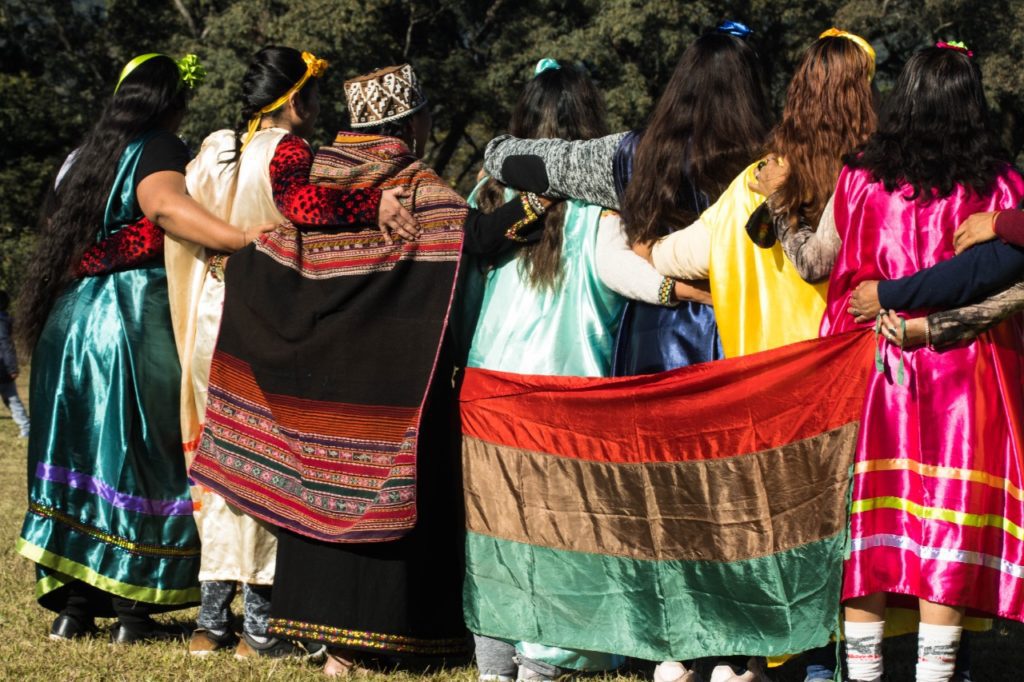
Many people both within and outside Argentina consider it to be mostly European. The popular imagination holds countries like Peru or Bolivia to have Indigenous identities, while Argentina is full of Italians, Spaniards, Germans and Britons. It’s a country of pizza, pasta, and steak, and Buenos Aires gets called “the Paris of Latin America.” Yet Argentina, the eighth-largest country in the world, has people from 40 different Indigenous nations, as women in the movement are quick to point out.
Both diversity and commonality among those present were evident right from the opening session. The crowd was a mass of hand-woven shawls of many colors, wide-brimmed hats, satin floral headbands, silver headdresses, and bright embroidered flowers. People introduced themselves in Quechua, Mapuzungún, Guaraní, Qom, and Aymara languages, among others. But just as evident was the breadth of catastrophic challenges everyone faces, and also their common root.

“I’ll be Indigenous anywhere, I’ll be Mapuche anywhere, and I’ll resist anywhere my body is needed,” said one attendee. It quickly became clear that resistance is needed everywhere. A Guaraní community spoke of having no access to water, while a Mapuche community told of the dam project threatening to flood their territory entirely. Communities from across north-central Argentina where soybeans rule spoke of constantly being sprayed with agricultural chemicals.
“We have many people with ulcers, with cancer, and when we go to the hospital they dismiss us,” said an attendee from northern Salta. “When we tell them that crop dusters spray the fields right next door, that the toxins blow into our homes, they ignore us and give us any reason but that one. Many people don’t even bother going to the hospital anymore.”
Others decried the continual clearing of forests for the soybeans to be planted in the first place. “Children are dying of malnutrition—food is scarce because they’ve blocked our access to the forest.”
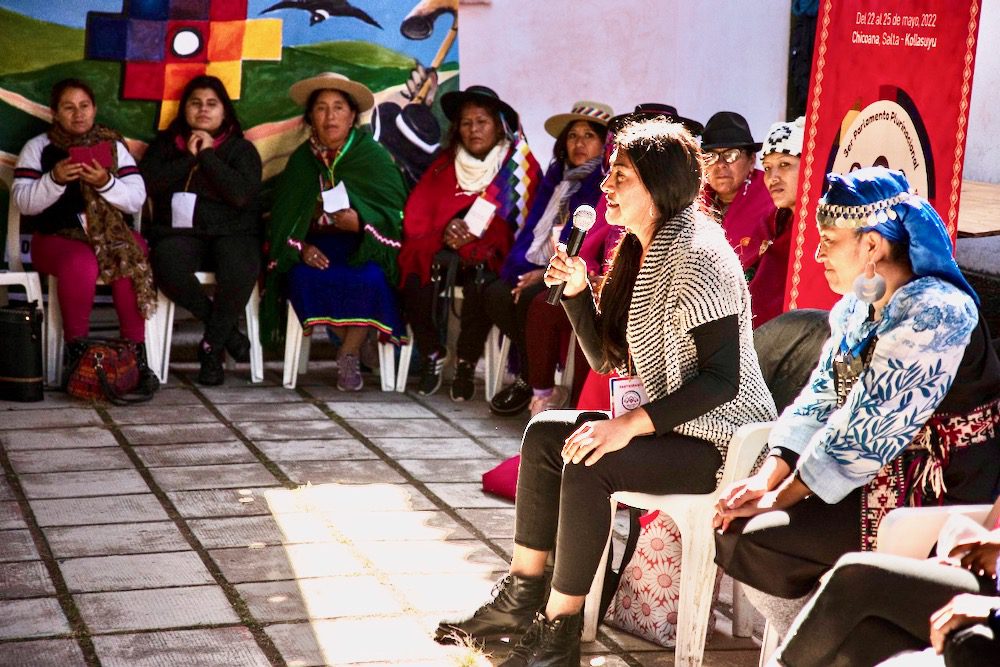
The conversation quickly honed in on this common thread—when territory is stolen or destroyed, everything else comes apart. Pía Ceballos, a Wichí-Guaraní trans activist, put it bluntly: “We didn’t move to the city because we like it. We went because they stole our territory. And it’s not as if they gave us nothing. They gave us the worst of the worst.” Pía’s participation, along with others’, also marked a deliberate effort on the part of the movement to include all kinds of queer, trans, and gender-nonconforming people.
Someone else chimed in with, “It’s not enough to say what they’re doing to us. You think they don’t know we have rights? That the land is ours? Enough with saying ‘we’re victims’ in all these different ways. What are we going to do about it?”
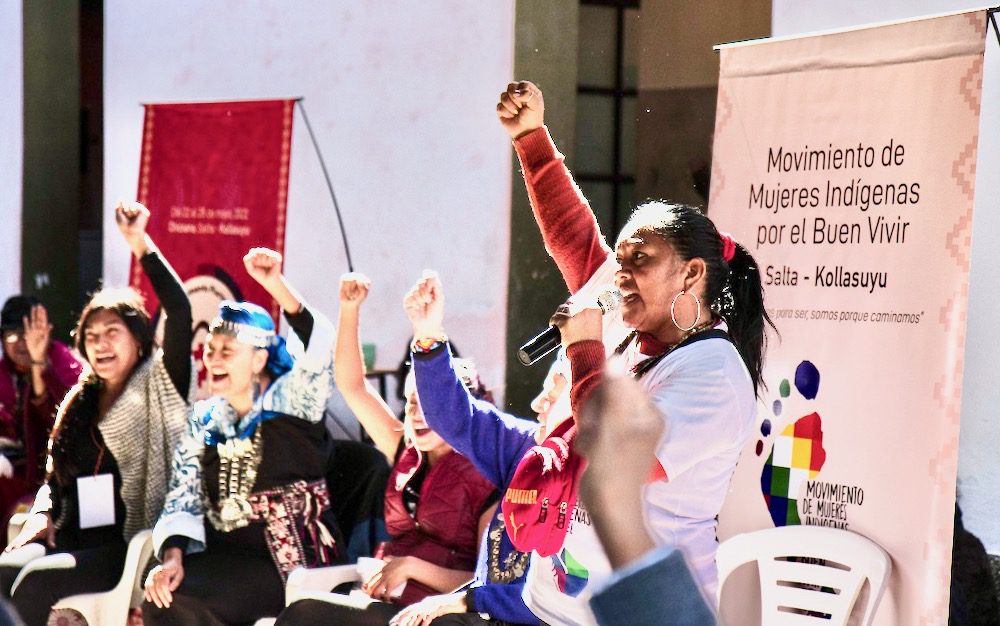
That question, what to do about the all-encompassing threats bearing down on everyone, carries the movement through a challenging borderland. On the one hand, the group is organizing women from communities in remote areas, often with little to no communications infrastructure (sometimes not even electricity.) On the other, to achieve change means connecting all the nodes of this network to pull simultaneously on the levers of power. This takes high levels of visibility, which in turn necessitates either intensive technology use or physical presence, preferably both.
But if technological access is limited, so is moving around the country—in addition to the expense, it’s especially onerous for those maintaining traditional subsistence lifestyles with animals and crops that can’t be left behind. So the Indigenous Women’s Movement has been pushing to develop a visible online presence with active social media campaigns addressing the various needs of communities across the country, but also undertaking direct actions.
In October 2019, two dozen women occupied the Ministry of the Interior in Buenos Aires for ten days in what they called “The Native Flower Rebellion,” with a list of demands. Even so, they were largely ignored by the national press as well as the government.
Moira Millán, a Mapuche weychafe (warrior), activist and co-founder of the Indigenous Women’s Movement, has spent years crisscrossing Argentina, visiting remote communities, making these connections that allow for everything from that occupation to this gathering, the third of its kind, and the first in three years, due to the pandemic.
This activism has earned her a lot of hatred. Even this event, which was not a direct action challenge to power but simply gathering women from diverse communities to discuss future plans, met harsh blowback. In the days leading up to it, Moira received threats of violence against her personally. In addition, the local Catholic church spread rumors that “Mapuches had taken over a local school,” painting it as a violent takeover to create no less than a terrorist enclave, and demanded the event be shut down. Thankfully, when police came to check on the situation, they found elderly women teaching local schoolchildren traditional dances and volunteers cooking gigantic pots of lentil stew to feed hundreds; they left without hindering any activities.
Now, with so many people finally face-to-face, the challenge is to join forces. Everyone here can see that spraying glyphosate in Qom territory up near Paraguay is closely related to pine plantations pushing Mapuches off their lands in Patagonia. But when the state has compartmentalized everything—separate provinces, separate ministries, separate municipalities, separate legislation—how to address them together? By linking everything to the need for territory and for a seat at the table.
“Here, there is no separation,” said Millán. “We are a movement rising from the Earth itself, and we deserve to be heard. We deserve to be treated as equals.”
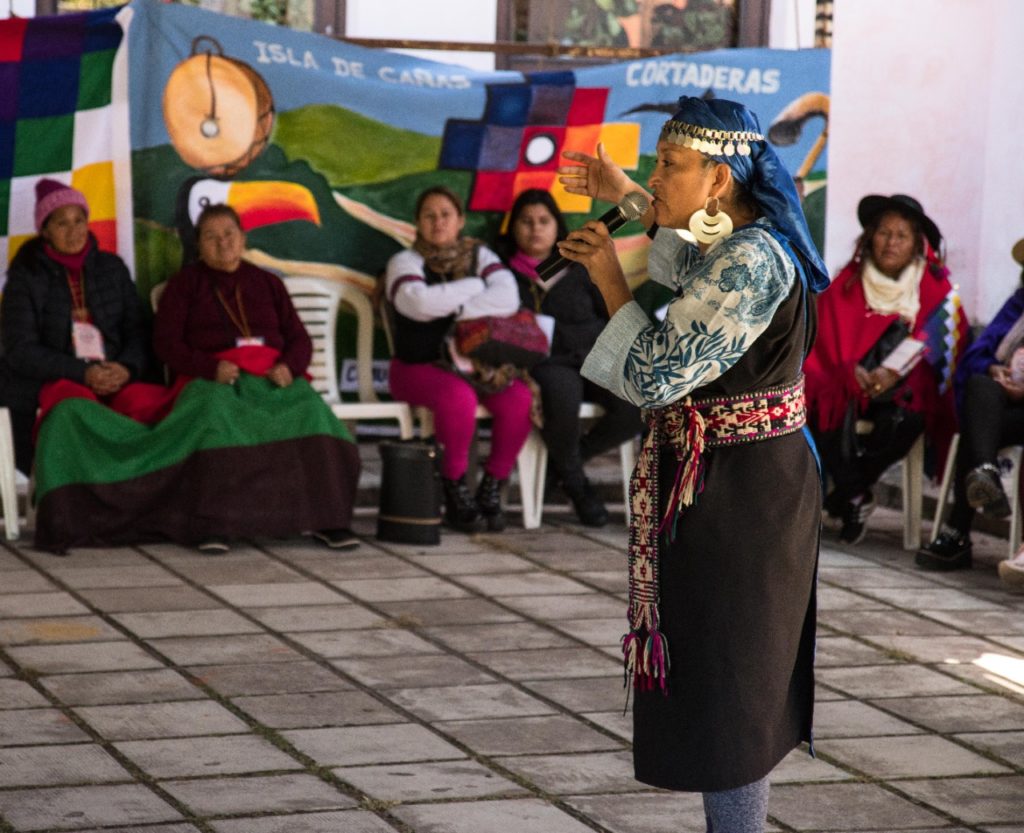
This demand to be treated as equals has two prongs: for the state to truly recognize Indigenous rights (Argentina’s constitution was amended in 1994 to recognize Indigenous peoples, but most say that only exists on paper), but also to recognize women as leaders and interlocutors.
“No more just talking to these caciques,” says Millán, referring to the official heads of some Indigenous groups, usually men, and often put in place by political power structures to suit their ends. “We demand the state dialogue directly with us, with the women of our nations.”
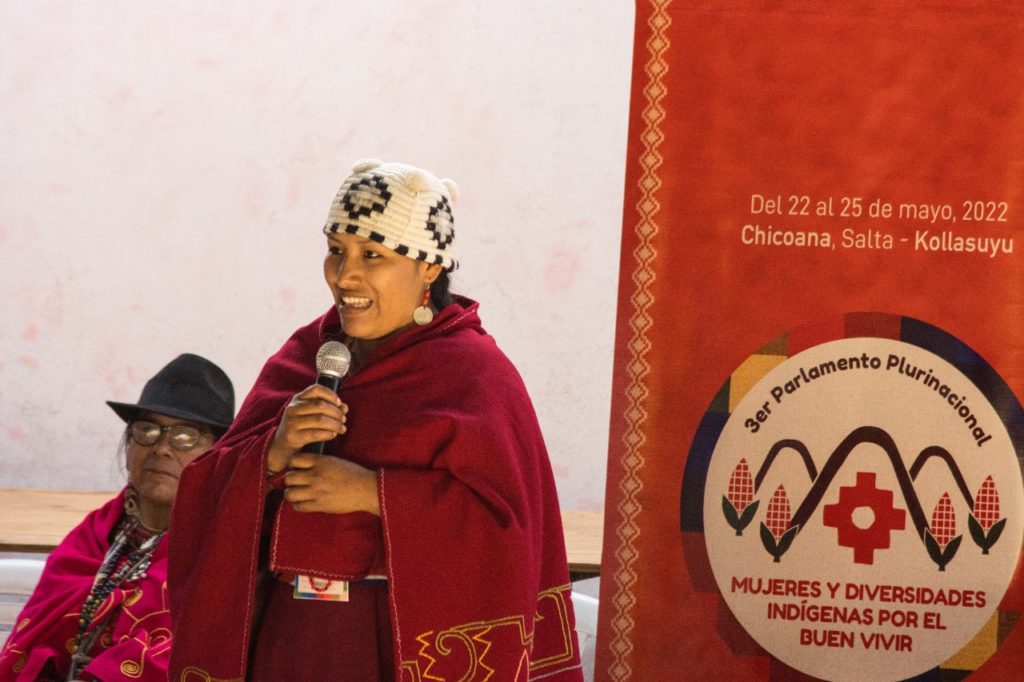
Creators for Good Living
Strategies discussed at the Parliament were far-reaching. Nelly Curia, a Mapuche ceramics artist, gave a workshop on cooperative economics as part of the ongoing Movimiento project “Hacedoras por el Buen Vivir (Creators for Good Living),” which aims to distribute traditional handicrafts made by women around the country.
“We’re creating an online platform for craftswomen to find people out there who truly value their labor and the ancestral history behind their artwork,” said Curia. “Economic sustainability in our communities is crucial. Most people are never paid anything close to what their work is worth. But we also talk about terricide, and the need to provide livelihoods that care for the natural elements we use in our craft.”
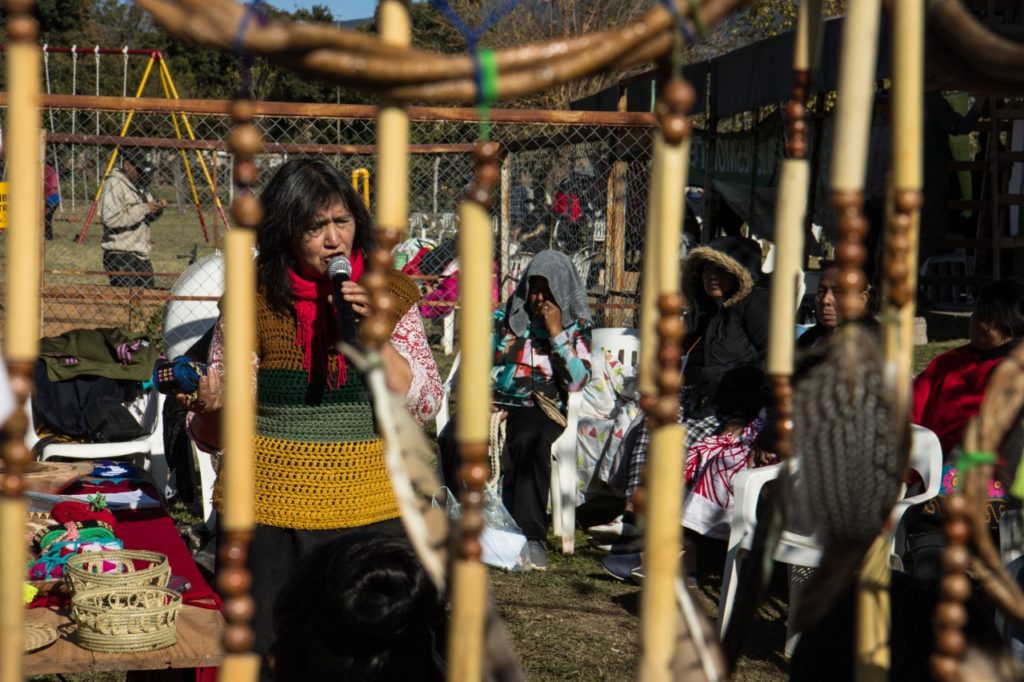
A stone’s throw away across the field, others led workshops on history, education, and Indigenous legal rights. Ana Fornaro and Maru Ludueña of Agencia Presentes, a feminist news agency based in Buenos Aires and covering all of Latin America, led a discussion about creating an Indigenous women’s news agency. This joint project of the Movimiento and Agencia Presentes has been in development for several months. “Mass media rarely cover Indigenous territories, and when they do, they often do so at a distance, over the phone, or without knowing much about what they’re talking about,” said Fornaro. “If Indigenous women can do their own reporting and have that picked up by the media, it would make coverage so much more true to reality.”
While the Indigenous Women’s Movement is forging alliances with feminist organizations like Agencia Presentes, they are careful to point out they are not, themselves, feminists. “Feminism is a current of thinking that comes from a particular context, a particular culture, and it’s not ours,” said Moira Millán. “Here in Indigenous America, we have other ways of relating to each other, of relating between genders. Patriarchy was a colonial imposition as well, and we’re going to get rid of it our way, not by using another European ideology.”
The shift they’re seeking is not just who is doing the reporting, but how. “There are so many different ways of communicating,” said a participant, holding up a piece of cloth. “Our ancestors communicated through these weavings. We would be wrong to try to boil everything down to the way most media communicate. There are also those who communicate, but have no voice; you have to listen differently. Water, for example, or mountains.”
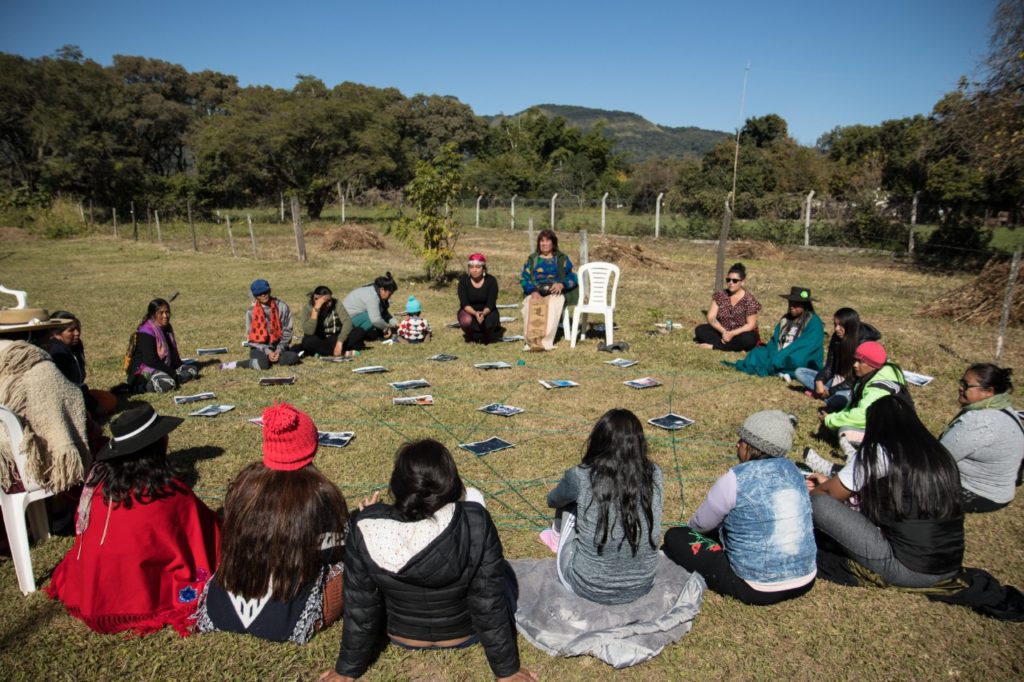
Indigenous alliances across Latin America
At this gathering, special guests Adelaida Cucue de Hernández and Alfa Coral Enríquez Reyes were invited from Mexico to tell of the Purépecha people’s successful resistance to drug traffickers and illegal loggers in Cherán, Michoacán.
“They were terrorizing us; hundreds of truckloads of logs were being hauled out of the forest every day, and people began to disappear,” said Cucue de Hernández. “And then a group of women confronted them. Until we took matters into our own hands and began to set up barricades, no one would listen to us. Human rights groups would come and say, ‘We’re going to write up a report,’ and then leave. Once we barricaded them out, they laid siege to our whole town, but we outlasted them and we now have self-rule in Cherán. We did this by organizing. You must organize yourselves.”
She stressed that the work to be done is all-encompassing. “Our ways of thinking are very important; we’re not ignorant. We need to revitalize our knowledge of language, astronomy, gastronomy, music, medicine, everything.”
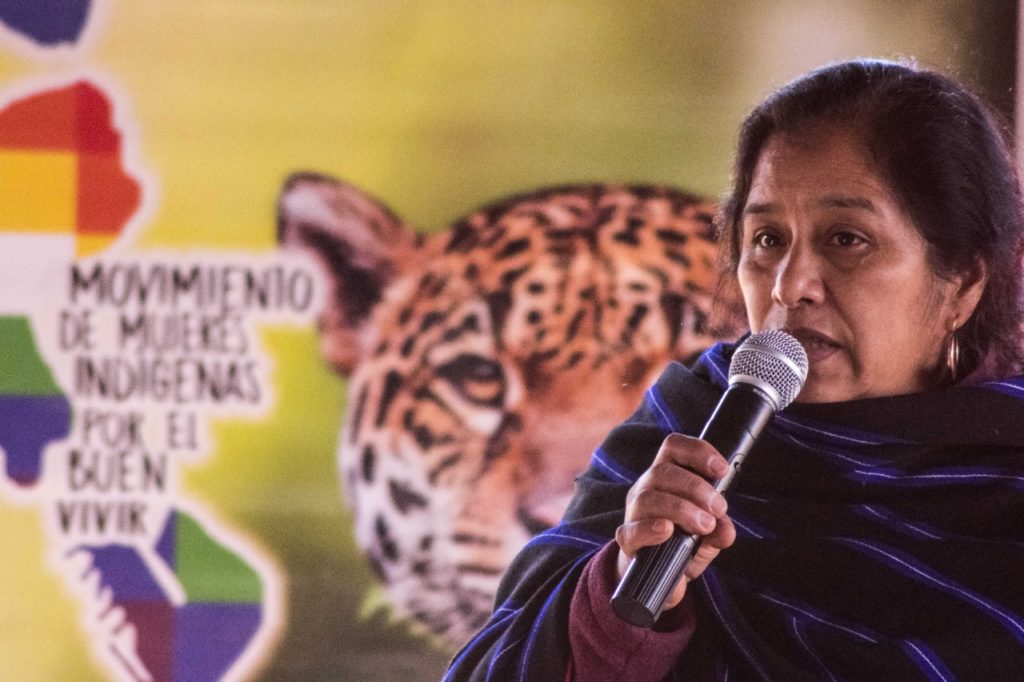
Everything is under attack, and everything is to be defended; hence, the concept of terricide. The Indigenous Women’s Movement has chosen not to use the term ecocide, implying the murder of the natural environment. The movement favors the word terricide, the murder of the world, which includes not just the natural environment but also human culture and understanding.
Traditional spirituality is another vital aspect of the Indigenous movement, and two other special guests were invited from Bolivia to lead ceremonies. Elena Martinez Quispe and Juana Eritsa Casaca, traditional healers from the Quechua and Aymara peoples, respectively, led ceremonies each day involving everyone present.
“Look, we are dealing with violence against land and against our bodies, but also against our spirits,” said Moira. “In so many cases, we’ve forgotten who we are. Ceremony helps us remember that.”
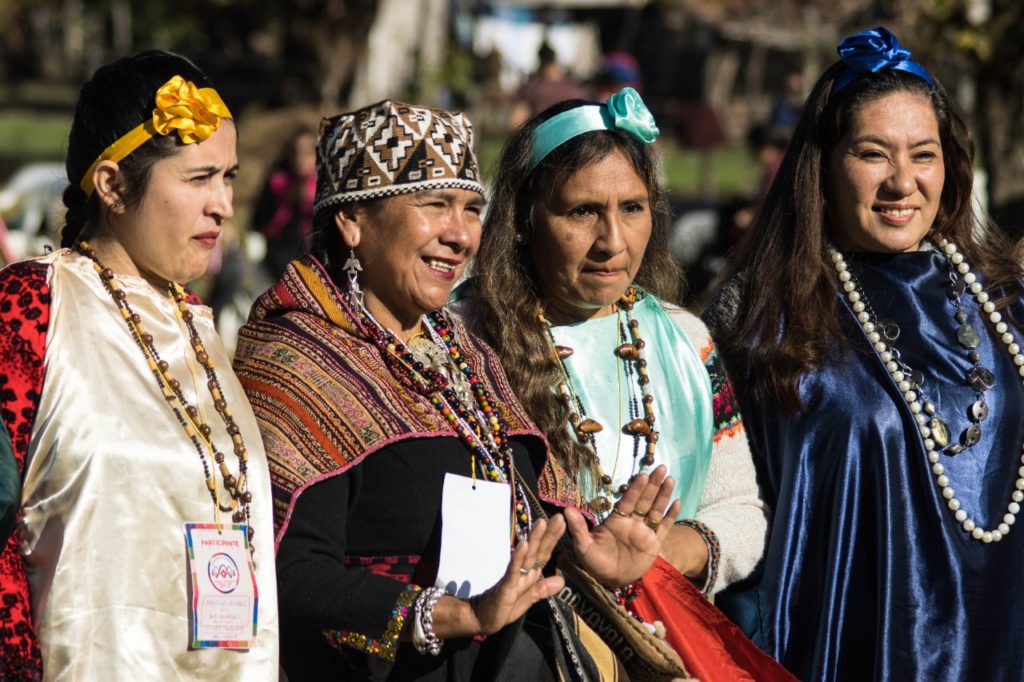
In some cases, that memory is leading people to reclaim stolen land. Especially in Patagonia, a growing land-back movement has been reclaiming ancestral Mapuche territory, but the power imbalance is striking. Soledad Cayunao told the gathering how she is reclaiming her family’s land around the headwaters of the Río Chubut, one of Patagonia’s major rivers.
The lower, winter pastures are held by a regional utility cooperative that controls telephone and gas services in the area, while the summer pastures at higher elevation are a private hunting estate in the hands of the former Emir of Qatar, multibillionaire Hamad bin Khalifa al Thani. Against such forces stand Soledad, her husband, and their three children. “It’s not just Mapuche territory,” said Cayunao. “We’re trying to protect the headwaters. This should matter to everyone.”
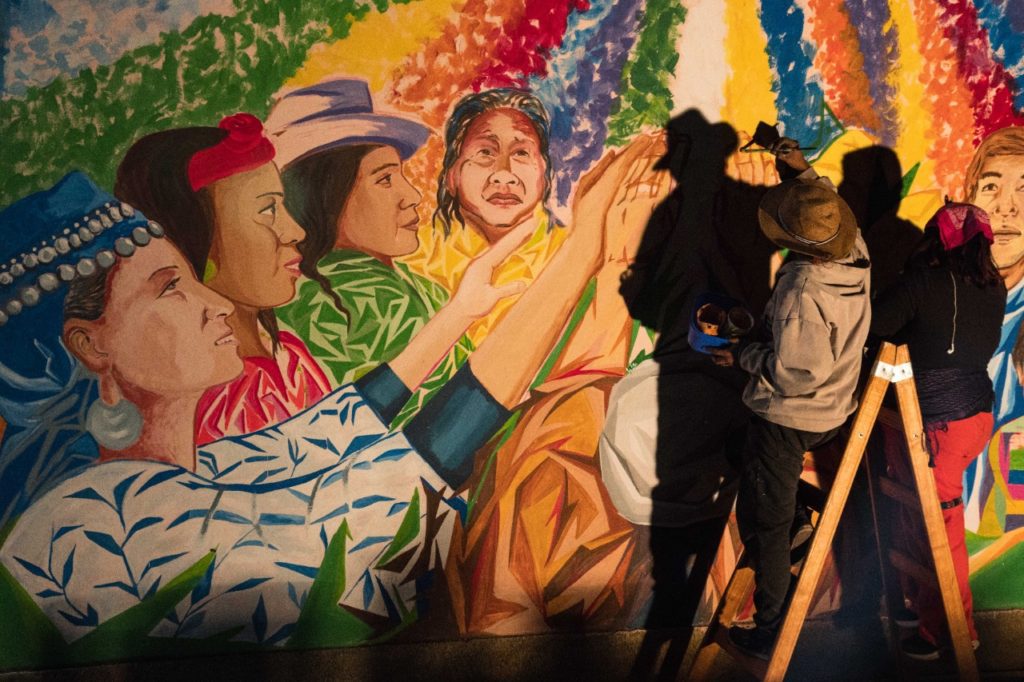
As the attendees began the long journeys back to their various homelands, they carried that challenge with them—how to make their struggles matter to everyone. One key decision made was to focus on water as crucial to all of these struggles, just as Soledad Cayunao pointed out. From communities lacking water access in Salta and Chaco, to the contamination of waterways with agrotoxins in the soybean belt, to oligarchs’ landgrabs snapping up water sources in Patagonia, water is quickly becoming a critical focal point.
Everyone also acknowledged that these struggles would be a long haul. The presence of children at the gathering was fundamental to that understanding. The movement specifically invited people to attend with their children, and activities were provided for them while mothers and grandmothers did the grown-up work. Some things take generations, an attendee named Eugenia, a Peruvian living in Argentina, pointed out.
“Look, my children don’t speak Aymara. It was too stigmatized for them to take it on. But now I’ve taught my grandchildren,” she said.
Some dangers may be too dire to wait a generation to solve. In the words of Adelaida Cucue de Hernández when closing her presentation about the Purépecha struggle, “The situation is critical.” Then she added, “But sisters, it’s very simple. The land is ours.”
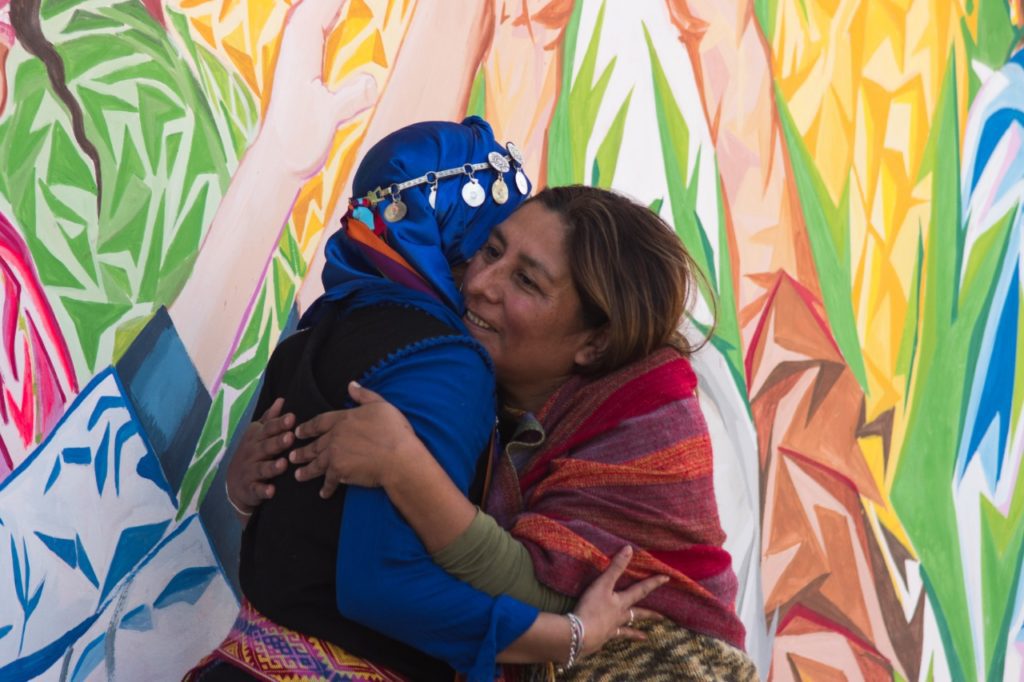
great article Tracy – forwarding it to many – caw
Many thanks my friend.